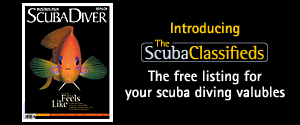- Home
- Directory
- Shop
- Underwater Cameras - Photographic Accessories
- Smartphone Housings
- Sea Scooters
- Hookah Dive Systems
- Underwater Metal Detectors
- Dive Gear
- Dive Accessories
- Diving DVD & Blu-Ray Discs
- Diving Books
- Underwater Drones
- Drones
- Subscriptions - Magazines
- Protective Cases
- Corrective Lenses
- Dive Wear
- Underwater Membership
- Assistive Technology - NDIS
- On Sale
- Underwater Gift Cards
- Underwater Art
- Power Stations
- Underwater Bargain Bin
- Brands
- 10bar
- AirBuddy
- Akona
- AOI
- Apollo
- AquaTech
- Atomic Aquatics
- aunoc
- AxisGo
- Backscatter Underwater Video and Photo
- BLU3
- Buddy-Watcher
- Cayago
- Chasing
- Cinebags
- Contour
- Deepblue
- Devilite
- Digipower
- DJI
- Dyron
- Edge Smart Drive
- Eneloop
- Energizer
- Exotech Innovations
- Fantasea
- FiiK Elektric Skateboards
- Garmin
- Geneinno
- GoPro
- Hagul
- Hoverstar
- Hydro Sapiens
- Hydrotac
- Ikelite
- Indigo Industries
- Inon
- Insta360
- Intova
- Isotta Housings
- Jobe
- JOBY
- Kraken Sports
- LEFEET
- Marelux
- Mirage Dive
- Nautica Seascooters
- Nautilus Lifeline
- NautiSmart
- Nocturnal Lights
- Nokta Makro
- Ocean Guardian
- Oceanic
- Olympus
- OM System
- Overboard
- Paralenz
- PowerDive
- QYSEA
- Ratio Dive Computers
- Scubajet
- Scubalamp
- Sea & Sea
- SeaDoo Seascooter
- SeaLife
- Seashell
- Seavu
- Shark Shield
- Sherwood Scuba
- Spare Air
- StickTite
- StormCase
- Sublue
- Suunto
- SwellPro
- T-HOUSING
- Tusa
- U.N Photographics
- Venture Heat
- XTAR
- Yamaha Seascooter
- Youcan Robot
- Zcifi
Cook Islands

The Cook Islands consist of 15 islands scattered over some 2 million square kilometers of the Pacific Ocean. They lie in the centre of the Polynesian Triangle, flanked to the west by the Kingdom of Tonga and Samoa and to the east by Tahiti and the islands of French Polynesia. When in the Cook Islands as a visitor, it appears that time stands still and the whole country exists just for your pleasure, with welcome smiles, warm eyes, and a friendly sense of humour. Lose track of time, you won't even know what day it is! So leave your energies on relaxing and soaking up the tropical lifestyle in the midst swaying coconut trees and balmy sea breezes.
The Cook Islands culture lives on in the vibrant performance of song and dance. Cook Islanders are considered among the finest Polynesian singers and dancers and awards come often in international contests.
Images courtesy of Cook Islands Tourism Corporation
In the Directory
Photos

- Rocky overhang at the beach

- Snorkeler in limestone cave

- Inflatable diveboat
Climate
The Cook islands enjoy a pleasantly warm and sunny climate all year round. June to August are the cooler months, whilst November to March marks the warmer season, with occasional tropical showers expected. The drier months from April to November have an average temperature of about 26¬?C, whilst the warmer, more humid and damp season runs from December to March. During this season the temperature ranges between 22¬?C and 28¬?C.
Underwater Recommendations
Rarotonga and Aitutaki are excellent for diving, snorkeling, and fishing. The outer reef area offers a diverse range of diving locations with superb visibility, usually ranging from 100 to 200 feet, depending on wind and weather. Canyons, caves and varieties of coral, make it a most unusual terrain. There are also wrecks to explore and fish to hand feed. Rarotonga boasts crystal clear waters and warm inviting temperatures between 23 and 30 degrees Celsius. All diving is shore based with the diving boats in the 5 to 7 meter size range. Trips usually depart in both the morning and afternoon.
Getting There
By air with Air New Zealand or Air Rarotonga.
In the Directory

Shopfront
-
 Sea Fishes of Southern Australia
Sea Fishes of Southern Australia
- The first complete field guide to the fishes of Australia’s southern half.
- $AU 27.95
- 10% Cardholder's Discount!







